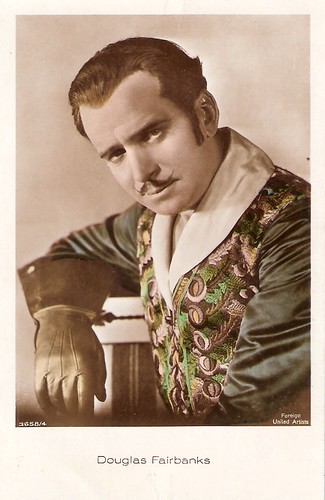
German postcard by Ross Verlag Foreign, no. 3658/4, 1928-1929. Photo: United Artists. Doug is wearing the outfit from Don Q, Son of Zorro (Donald Crisp, 1925).

German postcard by Ross Verlag, Berlin, no. 40/3. Photo: IFA / United Artists. Douglas Fairbanks in The Thief of Bagdad (Raoul Walsh, 1924).

Italian postcard by G.B. Falci Editore, Milano, no. 285. Photo: United Artists. Douglas Fairbanks and Lupe Velez in The Gaucho (F. Richard Jones, 1927).

German postcard by Ross Verlag, no. 3949/1, 1928-1929. Photo: United Artists.
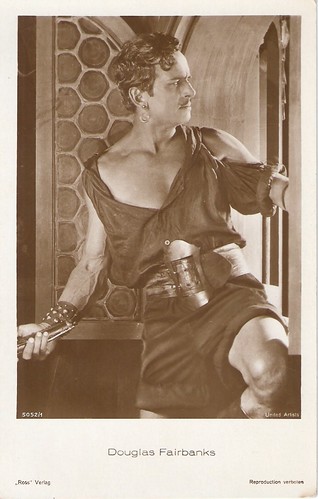
German postcard by Ross Verlag, no. 5052/1, 1930-1931. Photo: United Artists. Douglas Fairbanks in The Black Pirate (Albert Parker, 1926).

German postcard by Ross-Verlag, no. 5267/1, 1930-1931. Photo: K.O. Rahmn (Knut Olaf Rahmn) / United Artists. Douglas Fairbanks in The Taming of the Shrew (Sam Taylor, 1930).
Free-wheeling farces
Douglas Fairbanks was born Douglas Elton Thomas Ullman in 1883 in Denver, Colorado, the son of H. Charles Ullman, a prominent New York attorney, and ‘Southern belle’ Ella Adelaide Marsh. Ullman abandoned the family when Douglas was five years old and he and his older brother Robert were brought up by their mother, who gave them the family name Fairbanks, after her first husband.
Douglas Fairbanks began acting at an early age, in amateur theatre on the Denver stage, performing in summer stock, and becoming a sensation in the local theatre community. Fairbanks moved to New York to pursue an acting career. He joined the acting troupe of British actor Frederick Warde who had seen Fairbanks performing in Denver. In 1902, he made his Broadway debut as Florio in the Frederick Warde Company's production of The Duke's Jester.
In 1907, Fairbanks married Anna Beth Sully, the daughter of a wealthy industrialist. They had one son, Douglas Elton Fairbanks (1909), who later became known as the actor Douglas Fairbanks Jr. In 1915, the family moved to Los Angeles. The then 31-years old Fairbanks signed a contract with Triangle Pictures and began working under the supervision of D.W. Griffith.
His first film was titled The Lamb (W. Christy Cabanne, 1915), in which he debuted the athletic abilities that would gain him wide attention among theatre audiences. His athleticism was not appreciated by Griffith, however, and he was brought to the attention of Anita Loos and John Emerson, who wrote and directed many of his next films.
Fairbanks became the top moneymaker for Triangle, starring in an average of 10 pictures a year for a weekly salary of $2000. He specialised in comedies - not the slapstick variety, but free-wheeling farces in which he usually played a wealthy young man thirsting for adventure. In 1916, Fairbanks established his own company, the Douglas Fairbanks Film Corporation, and would soon get a job at Paramount. His films ranged from romances to wacky, madcap comedies, from social satires to Westerns.
At a party in 1916, Fairbanks met actress Mary Pickford, and the couple began an affair. In 1917, they joined Fairbanks's friend Charlie Chaplin selling war bonds by train across the U.S. Pickford and Chaplin were then the two highest-paid film stars in Hollywood. To curtail these stars' astronomical salaries, the large studios attempted to monopolise distributors and exhibitors. By 1918, Fairbanks was Hollywood's most popular actor, and within three years of his arrival, Fairbanks's popularity and business acumen raised him to the third-highest paid.
In late 1918, Sully was granted a divorce from Fairbanks, the judgment being finalised in early 1919. To avoid being controlled by the studios and to protect their independence, Fairbanks, Pickford, Chaplin, and D. W. Griffith formed United Artists in 1919, which created their own distributorship and gave them complete artistic control over their films and the profits generated. The company was kept solvent in the years immediately after its formation largely by the success of Fairbanks's films.

British postcard by "Pictures" Portrait Gallery, London, no. 107.

Swedish postcard by Förlag Nordisk Konst, Stockholm, no. 870. Photo: Triangle Film.

French postcard in the Les Vedettes de Cinéma series by A.N., Paris, no. 84. Photo: United Artists. Douglas Fairbanks on the set of Robin Hood (1922), with Charles Chaplin and Max Linder.
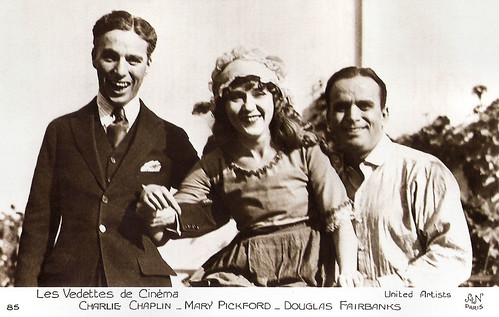
French postcard in the Les Vedettes de Cinéma series by A.N., Paris, no. 85. Photo: United Artists. Charles Chaplin, Mary Pickford, and Douglas Fairbanks.
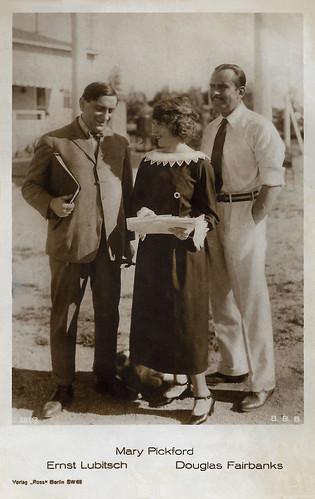
Charlie Chaplin, Ernst Lubitsch, Mary Pickford and Douglas Fairbanks. German postcard by Ross Verlag, no. 581/3, 1919-1924. Photo: B.B.B.

German postcard by Ross Verlag, no. 860/2, 1925-1926. Photo: A.B.C. Berlin-Steglitz. Douglas Fairbanks and Mary Pickford in Berlin. In 1926, Pickford and Fairbanks visited Berlin and stayed at the Hotel Adlon near the Brandenburg Gate, which is in the background of this picture.

American postcard by the Western Publishing & Novelty Co., Los Angeles, Calif., no. 850. Caption: Mary and Doug at home 'Pickfair', Beverly Hills, California.

German postcard by Ross Verlag, Berlin, no. 40/1. Photo: IFA / United Artists. Douglas Fairbanks in The Thief of Bagdad (Raoul Walsh, 1924).

German postcard by Ross Verlag, Berlin, no. 40/2. Photo: IFA / United Artists. Douglas Fairbanks in The Thief of Bagdad (Raoul Walsh, 1924).
‘Everybody's Hero’ and ‘America's Sweetheart
Douglas Fairbanks was determined to have Mary Pickford become his wife, but she was still married to actor Owen Moore. He finally gave her an ultimatum. She then obtained a fast divorce in the small Nevada town of Minden and the couple married in 1920. The public went wild over the idea of ‘Everybody's Hero’ marrying ‘America's Sweetheart’. They were greeted by large crowds in London, Amsterdam, and Paris during their European honeymoon, becoming Hollywood's first celebrity couple. Fairbanks and Pickford were regarded as ‘Hollywood Royalty’, famous for entertaining at their 42-room mansion in Beverly Hills, Pickfair.
By 1920, Fairbanks had completed twenty-nine films (twenty-eight features and one two-reel short), which showcased his ebullient screen persona and athletic ability. Fairbanks had been a comic in his previous films, but by 1920, he had the inspiration of staging a new type of adventure-costume picture, a genre that was then out of favour with the public.
In The Mark of Zorro (Fred Niblo, 1920), Fairbanks combined his appealing screen persona with the new adventurous costume element. This genre-defining Swashbuckler adventure was the first film version of 'The Mark of Zorro'. It was a smashing success and parlayed the actor into the rank of superstar.
For the remainder of his career in silent films, Fairbanks continued to produce and star in ever more elaborate, impressive costume films, such as The Three Musketeers (Fred Niblo, 1921), Robin Hood (Allan Dwan, 1922), The Thief of Bagdad (Raoul Walsh, 1924), The Black Pirate (Albert Parker, 1926, the first full-length Technicolor film), and The Gaucho (F. Richard Jones, 1927) with Lupe Velez.
Fairbanks spared no expense and effort in these films, which established the standard for all future swashbuckling films. In 1921, he, Mary Pickford, Charles Chaplin, and others, helped to organise the Motion Picture Fund to assist those in the industry who could not work, or were unable to meet their bills. During the first ceremony of its type, in 1927, Fairbanks and Pickford placed their hand and footprints in wet cement at the newly opened Grauman's Chinese Theatre in Hollywood. Fairbanks was elected first President of the Motion Picture Academy of Arts and Sciences that same year, and he presented the first Academy Awards at the Roosevelt Hotel. Today, Fairbanks also has a star on the Hollywood Walk of Fame at 7020 Hollywood Boulevard.

German postcard by Ross Verlag, no. 1686/1, 1927-1928. Photo: United Artists. Douglas Fairbanks in The Black Pirate (Albert Parker, 1926).

German postcard by Ross-Verlag, no. 1686/3, 1927-1928. Photo: United Artists. Douglas Fairbanks in The Black Pirate (Albert Parker, 1926).

German postcard by Ross Verlag, no. 1686/4, 1927-1928. Photo: United Artists. Douglas Fairbanks in The Black Pirate (Albert Parker, 1926).
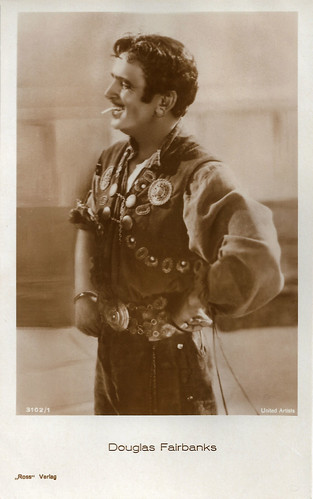
German postcard by Ross Verlag, no. 3102/1, 1928-1929. Photo: United Artists. Douglas Fairbanks in The Gaucho (F. Richard Jones, 1927).
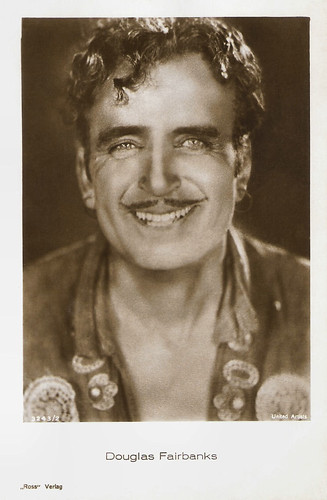
German postcard by Ross Verlag, no. 3243/2, 1928-1929. Photo: United Artists. Douglas Fairbanks in The Gaucho (F. Richard Jones, 1927).

German postcard by Ross Verlag, no. 3658/1, 1928-1929. Photo: United Artists. Douglas Fairbanks and Juliette Belanger in Don Q Son of Zorro (Donald Crisp, 1925).

German postcard by Ross Verlag, no. 3658/2, 1928-1929. Photo: United Artists. Douglas Fairbanks in Don Q, Son of Zorro (Donald Crisp, 1925).

German postcard by Ross Verlag, no. 3658/3, 1928-1929. Photo: United Artists. The card depicts a moment in The Three Musketeers (Fred Niblo, 1921), but stems from the time when Fairbanks made the sequel to The Three Musketeers: The Iron Mask (Allan Dwan, 1929).
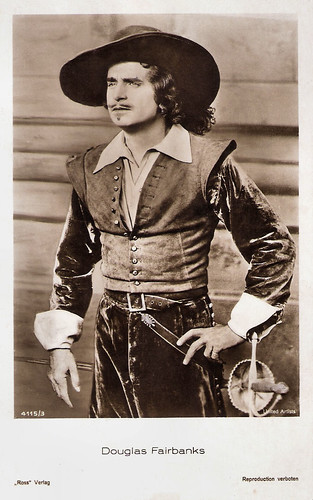
German postcard by Ross Verlag, no. 4115/3, 1929-1930. Photo: United Artists. Douglas Fairbanks in The Iron Mask (Allan Dwan, 1929).

German postcard by Ross Verlag, no. 4429/1, 1929-1930. Photo: United Artists. Douglas Fairbanks in The Black Pirate (Albert Parker, 1926).
Colossal Disaster
While Douglas Fairbanks had flourished in the silent genre, the restrictions of early sound films dulled his enthusiasm for film-making. He was 44 years old, and could no longer look the part of the youthful swashbuckler or romantic lead, nor could he safely perform the dangerous stunts his audiences expected of him.
In 1929, at Pickford's bungalow, United Artists brought together Pickford, Fairbanks, Charles Chaplin, Norma Talmadge, Gloria Swanson, John Barrymore, D.W. Griffith, and Dolores del Rio to speak on the radio show 'The Dodge Brothers Hour' to prove Fairbanks could meet the challenge of talking movies.
Fairbanks's last silent film was the lavish The Iron Mask (Allan Dwan, 1929), a sequel to The Three Musketeers (Fred Niblo, 1921). The Iron Mask included an introductory prologue spoken by Fairbanks. He and Pickford chose to make their first talkie as a joint venture, playing Petruchio and Kate in William Shakespeare's The Taming of the Shrew (Sam Taylor, 1929). The film was a colossal disaster, and the pair fought constantly during its making. When it flopped at the box office, Doug and Mary blamed each other.
Doug’s subsequent sound films were also poorly received by Depression-era audiences. The last film in which he acted, was the British production The Private Life of Don Juan (Alexander Korda, 1934), with Merle Oberon. The film is a revealing look at the life of the aging Don Juan, whose reputation has outrun him. The film, based on the 1920 play 'L'homme à la Rose' by Henry Bataille, was made by Alexander Korda's London Film Productions at Elstree Studios and distributed by United Artists under an agreement Korda had recently signed with them.
Fairbanks and Pickford separated in 1933 after he began an affair with Sylvia, Lady Ashley. They divorced in 1936, with Pickford keeping the Pickfair estate. Within months Fairbanks and Ashley were married in Paris. He continued to be marginally involved in the film industry and was disturbed by the new direction of his own company, United Artists, now under the iron fist of Samuel Goldwyn. His health continued to decline, and in his final years, he lived in Santa Monica, California, although much of his time was spent traveling abroad with Sylvia. At the end of 1939, Fairbanks had a mild heart attack. He died later that day at his home in Santa Monica. He was 56. Fairbanks's famous last words were "I've never felt better".
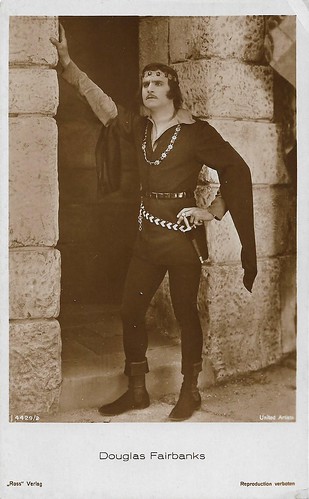
German postcard by Ross Verlag, no. 4429/2, 1929-1930. Photo: United Artists. Douglas Fairbanks in Robin Hood (1922).

German postcard by Ross Verlag, no. 4777/1, 1929-1930. Photo: United Artists. Douglas Fairbanks in The Black Pirate (Albert Parker, 1926).

German postcard by Ross Verlag, no. 4777/2, 1929-1930. Photo: United Artists.

German postcard by Ross-Verlag, no. 5052/2, 1930-1931. Photo: United Artists.

German postcard by Ross-Verlag, no. 5212/1, 1930-1931. Photo: K.O. Rahmn (Knut Olaf Rahmn) / United Artists. Douglas Fairbanks in The Taming of the Shrew (Sam Taylor, 1930).

German postcard by Ross-Verlag, no. 5212/2, 1930-1931. Photo: K.O. Rahmn (Knut Olaf Rahmn) / United Artists. Douglas Fairbanks in The Taming of the Shrew (Sam Taylor, 1930).
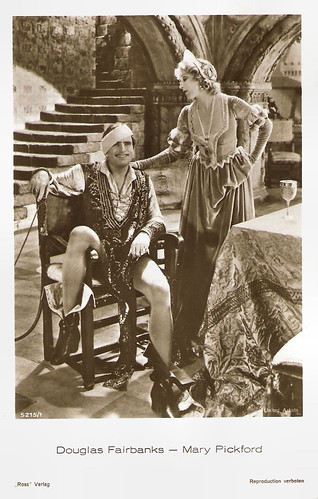
German postcard by Ross-Verlag, no. 5215/1 1930-1931. Photo: K.O. Rahmn (Knut Olaf Rahmn) / United Artists. Douglas Fairbanks and Mary Pickford in The Taming of the Shrew (Sam Taylor, 1930).

German postcard by Ross-Verlag, no. 6515/2, 1931-1932. Photo: United Artists. Douglas Fairbanks in Mr. Robinson Crusoe (Edward Sutherland, 1932).
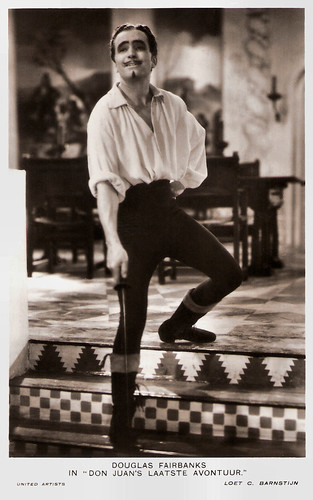
Dutch postcard. Photo: Loet C. Barnstijn / United Artists. Douglas Fairbanks in The Private Life of Don Juan (Alexander Korda, 1934).
Sources: Hal Erickson (AllMovie), Ed Stephan (IMDb), The Douglas Fairbanks Museum, Wikipedia, and IMDb
No comments:
Post a Comment